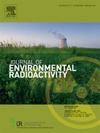放射性废物储存设施影响区内钚污染的评估
IF 2.1
3区 环境科学与生态学
Q3 ENVIRONMENTAL SCIENCES
引用次数: 0
摘要
放射性废物贮存设施是潜在的放射性污染源。位于奥布宁斯克的RWSF是俄罗斯最古老的组织之一。在1998年至1999年期间,检测到储油罐泄漏。没有关于放射性废物成分的准确信息。钚由于其长半衰期和放射性毒性而受到特别关注。本研究的目的是评估核聚变反应器影响区内的环境钚污染。采用初步放射化学分离的α光谱法对土壤和植物中的钚活性浓度进行了分析。已经确定,污染区域被限制在距离储存边界50米的区域内。在95厘米以下的土壤中观察到钚的浓度。在95厘米深的土壤中检测到钚。垂直分布不规则,表明通过地下水运移。草本植物对钚的转移因子在7.9·10−4 ~ 2.7·10−1之间,根系吸收最多。灌木的转运因子在3.4·10−3 ~ 1.1·10−1之间,以浆果群的转运系数最高。在树木中,转移因子在木材中为1.5·10−5,在针叶中为1.3·10−2,在叶片中高达6.8·10−2。本文章由计算机程序翻译,如有差异,请以英文原文为准。

Assessment of plutonium contamination in the zone of influence of a radioactive waste storage facility
Radioactive waste storage facilities (RWSF) are potential sources of radioactive contamination. The RWSF located in the Obninsk is one of the oldest in Russia. Between 1998 and 1999 was detected the leakage from storage tanks. There is no accurate information on the radioactive waste composition. Plutonium attracts special attention due to its long half-life and radiotoxicity. The purpose of this study is to assess plutonium contamination of environment in the RWSF zone of influence. The analysis of plutonium activity concentration in soil and plants was carried out using alpha spectrometry with preliminary radiochemical separation. It has been established that the area of contamination is limited to a 50 m zone from the border of storage. Plutonium concentrations in soil are observed down to 95 cm. Plutonium was detected in soils down to a depth of 95 cm. The irregular vertical distribution indicates migration via groundwater. Plutonium transfer factors to herbaceous vegetation ranged from 7.9·10−4 to 2.7·10−1, with the highest uptake observed in the root systems. For shrubs, transfer factors ranged from 3.4·10−3 to 1.1·10−1, with the highest concentrations found in berry clusters. In trees, transfer factors ranged from 1.5·10−5 in wood, to 1.3·10−2 in needles, and up to 6.8·10−2 in leaves.
求助全文
通过发布文献求助,成功后即可免费获取论文全文。
去求助
来源期刊

Journal of environmental radioactivity
环境科学-环境科学
CiteScore
4.70
自引率
13.00%
发文量
209
审稿时长
73 days
期刊介绍:
The Journal of Environmental Radioactivity provides a coherent international forum for publication of original research or review papers on any aspect of the occurrence of radioactivity in natural systems.
Relevant subject areas range from applications of environmental radionuclides as mechanistic or timescale tracers of natural processes to assessments of the radioecological or radiological effects of ambient radioactivity. Papers deal with naturally occurring nuclides or with those created and released by man through nuclear weapons manufacture and testing, energy production, fuel-cycle technology, etc. Reports on radioactivity in the oceans, sediments, rivers, lakes, groundwaters, soils, atmosphere and all divisions of the biosphere are welcomed, but these should not simply be of a monitoring nature unless the data are particularly innovative.
 求助内容:
求助内容: 应助结果提醒方式:
应助结果提醒方式:


